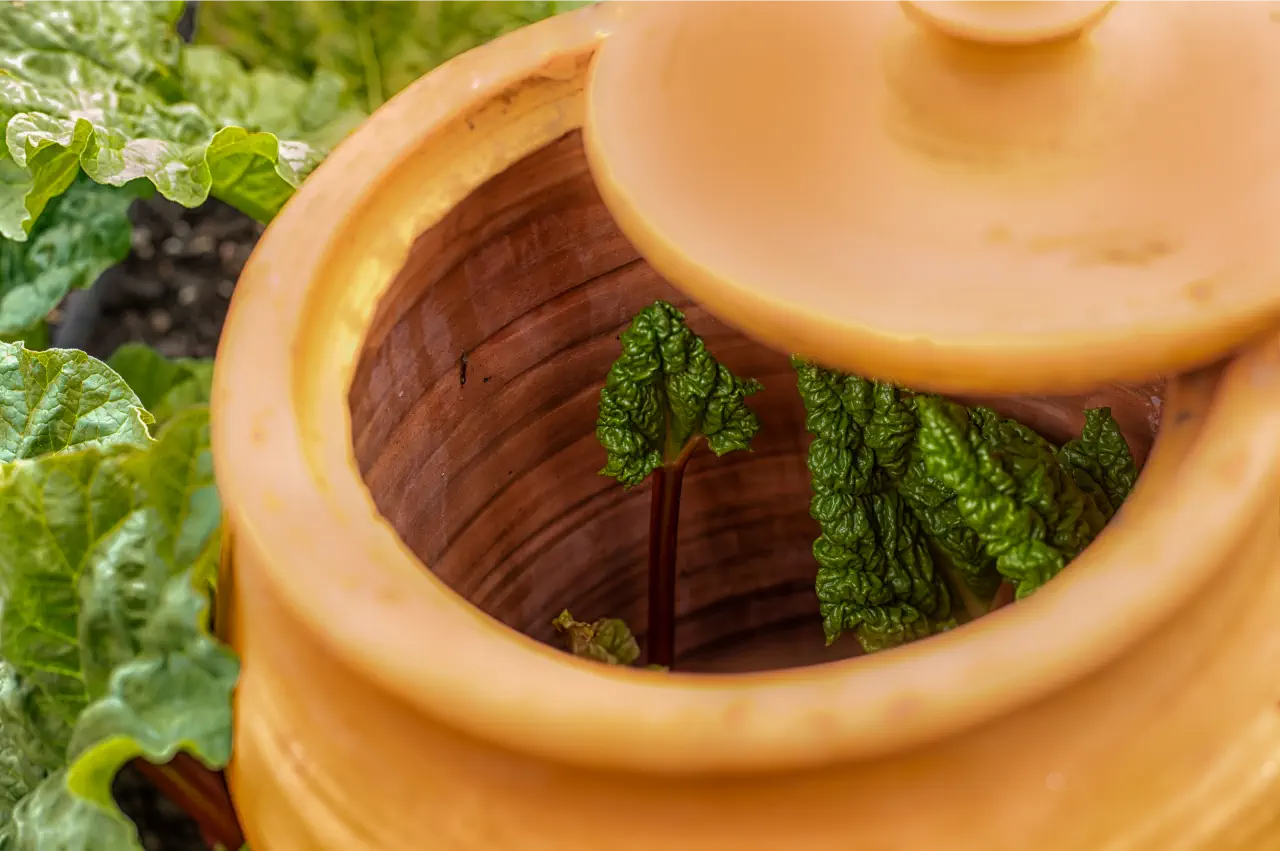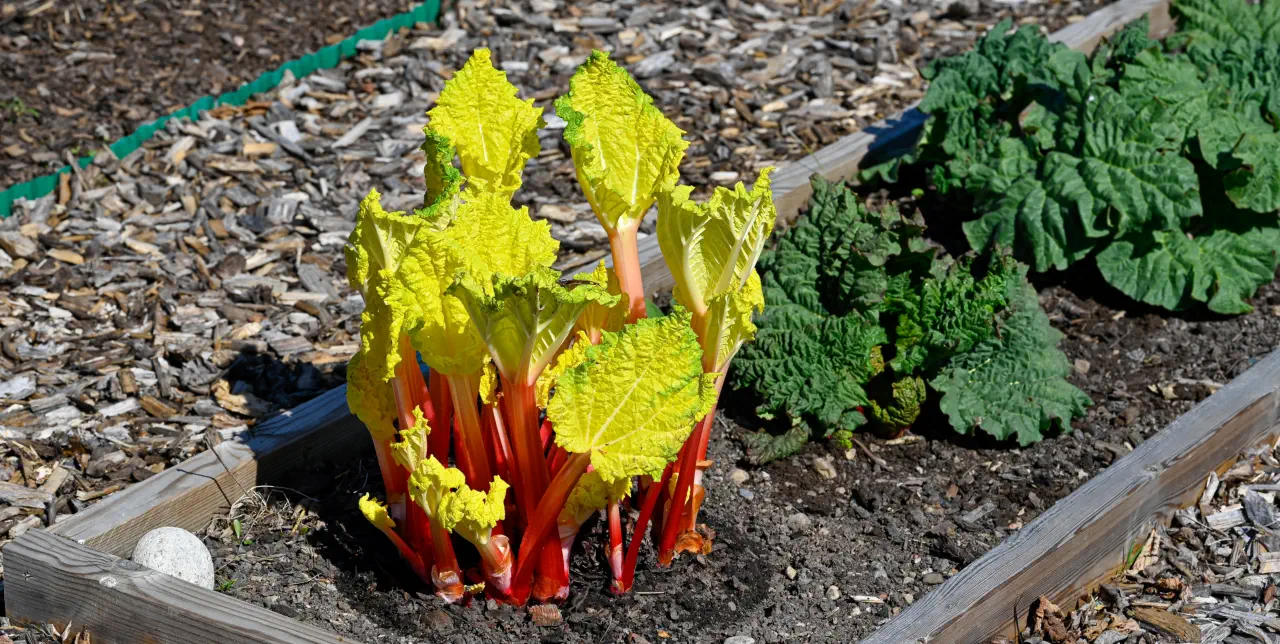Pak Choi is grown for its tasty leaves which are superb when added to stir fries and salads.
The taste is similar to that of mild cabbage and spinach and is a popular addition to many oriental dishes.

As the saying goes, the early bird gets the worm, and in your case, the early gardener gets the rhubarb. You're likely to be no stranger to the reward of fresh, home-grown produce, but imagine having your tart and tasty rhubarb ready a full month ahead of the usual season.
This is where the technique known as 'forcing' comes into play. This blog will gently walk you through the steps to successfully force rhubarb, from the timing, and the care needed for this process.
Curious about how to get your hands on that early harvest? Stay with us, as we unravel this gardener's secret.
To fully grasp the concept of rhubarb forcing, it's crucial to understand that this process involves stimulating the rhubarb plant to produce stems ahead of its natural growth cycle, providing an early harvest of tender, sweet, and brightly-coloured stems. The benefits of forcing are numerous; it affords a harvest about a month earlier than the natural growth, the stems have less bitterness and a more delicate taste, and they require less sugar to balance their tartness.
Forcing techniques involve the use of purpose-made forcing containers or any strong upturned pot. These containers block out light, tricking the plant into thinking it's still winter, thus stimulating early growth. You also need to create a snug microclimate by banking straw around the pot. However, there are also alternative forcing methods. You can pot up a portion of rhubarb crown in a greenhouse or warm location, maintaining slightly moist roots and a temperature of 18-20°C for the speediest crop.
While forcing rhubarb offers many benefits, it's not without challenges. Forced crowns should be left to recover the following year to avoid weakening the plant. Rhubarb crowns need a period of chilling to ensure stronger growth and thicker stems. Condition the crowns with a proper rest period for improved fruiting potential. It's recommended to have multiple plants to alternate between forcing and rest periods.
With proper techniques and understanding, you can reap the benefits of early, sweet, and tender rhubarb harvests.
Sign up for the SimplySeed newletter to receive our free advice emails, direct to your inbox.
When planning to force your rhubarb for an early harvest, you'll need to pay close attention to timing and prepare the plant and its environment correctly. Rhubarb forcing generally starts in late winter, when the plant is dormant, so January / Early February. This is when you'll want to put your forcing containers in place. Traditional forcing pots, or even simple buckets, can be used. The key is to completely block out light to the plant, prompting it to start producing early.
There are benefits to forcing, including a harvest that's both earlier and often more tender than a regular crop. The forced stems also usually have a more vibrant colour and sweeter flavour. However, it's important to remember that forcing is a stressful process for the plant, so you should let it rest and recuperate for a year or two after a forced crop.
Choosing the right method for forcing your rhubarb is crucial to achieving an early, vibrant, and tasty harvest. Among the various forcing techniques, one traditional method involves covering your rhubarb plant with a large pot or bucket, or even a specialized rhubarb forcer.
Your choice of forcing equipment plays a significant role in the success of this process. Whether you opt for a traditional rhubarb forcer or decide to use a large pot or bucket, ensure that it's large enough to cover the entire crown of your rhubarb plant. Remember to cover any holes or cracks to prevent light from reaching the plant. Insulating the pot with straw, bubble wrap, or sheeps wool can speed up the forcing process.
Here's a success tip to remember. After forcing, let your rhubarb rest for a year. This allows the plant to recover, ensuring a healthy harvest in the following seasons.
Proper care for your forced rhubarb ensures a bountiful and healthy harvest, starting with regular watering and the right nutrients. A watering regimen will depend on your specific environment, but generally, you should keep the soil moist, not waterlogged. Overwatering can lead to root rot, a common issue with forced rhubarb.
One of the key fertilisation techniques involves applying a layer of compost or horse manure. This gives your rhubarb the nutrients it needs to produce healthy, succulent stems. If you're using container gardening methods, ensure the pots have ample drainage to avoid waterlogging.
Don't be worried if your rhubarb's leaves turn yellow during the forcing process - this is a normal response to the lack of light. However, if your stems are thin or your plant looks unhealthy, it might be struggling with nutrient deficiencies or disease.

After nurturing your forced rhubarb with careful attention and patience, you'll reach the rewarding stage of harvesting these tender, flavourful stems. When the stalks are about 30cm long and exhibit a vibrant pink hue, they're ready for picking. Gently twist and pull each stem from the base, ensuring you don't damage the crown.
Forced rhubarb, with its more delicate flavour, presents a range of unique culinary opportunities. Its soft texture and sweet-tart taste make it a favourite for a variety of recipes using forced rhubarb. From classic rhubarb pies and crumbles to sophisticated sauces and compotes, it's a versatile ingredient that'll add a fresh, tangy twist to your dishes.
When it comes to storing your harvest, cleanliness is key. Remove any leafy parts and clean the stems well before storing in the fridge. They'll remain fresh for about a week. For longer storage, consider freezing the washed and diced stems.
Forcing rhubarb truly revolutionizes your gardening experience, offering an early taste of spring's bounty. With careful timing, appropriate methods, and diligent care, you'll savour a fruitful early harvest.
Remember, nurturing your rhubarb stock ensures a continuous yield. So why wait for nature's pace? Embrace the art of forcing rhubarb and let your garden be the harbinger of spring.
Happy gardening, and here's to many years of delicious, home-grown rhubarb!
All blog content on this page is copyright of SimplySeed and is not to be reproduced without prior written permission. ©